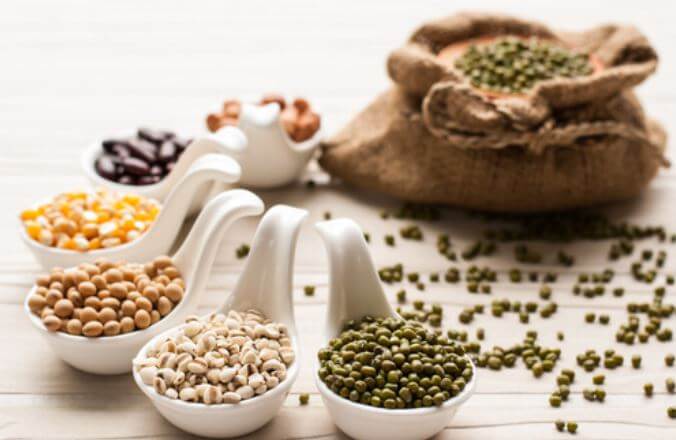Cretan Diet: its Amazing Benefits

Whether to assist with a health problem or simply as a way of enjoying its benefits, we can use existing dietary models tested by professionals. The Cretan diet is one of them, and this article will delve into its main characteristics.
The Cretan diet: nutrition and Greek culture
Ancient Greek culture has taught us a lot. These lessons are applied today to lead an integral and healthy life, both physically and mentally. Among them, we have a food structure called the Cretan diet, which today is reflected in what we know as the Mediterranean diet.
It isn’t clear if brave warriors of the times such as Achilles or Atalanta were real or mythological beings. However, their stories have inspired many of us to take a path linked to the cult of the body and its corresponding well-being.
Within the fundamental aspects of our physical care, we must pay special attention to nutrition. From the Greeks, we learned the dietary basis to achieve, along with proper training, a healthy life.
Origin and basis of the Cretan diet
In Greece, there’s an island called Crete, and its natural environment provides citizens with a series of magnificent foods. These help them control optimal levels of nutrients and achieve a quality body composition. These foods, optimally cooked, reward their consumers with high-value food resources.
Mainly, the Cretan eating plan consists of fruits, vegetables, legumes, cereals, meat, and fish. Of course, they also complement these foods with dairy products and olive oil, all in adequate proportions.
These ingredients are also included in beneficial menus and currently valued within the world cuisine. Of course, a key factor is the dressing of dishes with aromatic plants full of nutritional properties.

Examples of food withing Cretan culture
Within this food structure, we can find recipes such as a salad with nuts accompanied by white fish, whole wheat bread and an apple. Another option is grilled salmon with legumes, added to a dairy product. We also have poultry with tomatoes, seasoned with aromatic herbs and pears, among other examples.
Within the Cretan diet, wine is obviously included. This, as long as it’s a measured consumption, doesn’t have to cause health problems. This is especially true if the wine belongs to a natural crop without chemical additives.
The structure of the Cretan diet is very similar to the Mediterranean diet, with only slight variations in their proportions. Still, the goal is practically the same: health. Of course, this diet should be accompanied by a minimum of daily physical activity and enough hours of sleep.
Benefits of the Cretan diet
The benefits of the Cretan diet are mainly related to the cardiovascular aspect, lessening the risk of cardiovascular disease. Because of this, we can highlight its benefits regarding the following health problems:
High blood pressure
The Cretan diet has very positive effects in cases of overweight. By applying it, due to its almost imperceptible cholesterol levels, we gradually reduce body fat levels.
Cerebrovascular accident
These systemic failures could cause death. As we can see, neglecting what we eat necessarily leads to progressive degeneration of our nervous system. Opting for the natural foods suggested by this regime is more than convenient.
The Cretan diet helps to reduce the risk of arrhythmias
One of the problems that cause arrhythmias is the obstruction in the arteries of the heart. Often, obesity and the consumption of unhealthy foods generate these obstructions. To reduce these cardiovascular risks, the following aspects must be met:
- Reduce saturated fat intake
- Preferably use vegetable oils
- Eat vegetables, fruits and skim milk
- Do not abuse salt or refined sugar
- Avoid tobacco, alcohol, and other substances

Other advantages of the Cretan diet
Beyond being good for cardiovascular health, we can also add the following benefits of the Cretan diet:
Metabolism improvement
The antioxidant components of these foods help release free radicals and, as a consequence, metabolism improvement occurs.
Strengthens the immune system
In the face of possible diseases caused by environmental factors, you have to try and have the strongest immune system possible. With a healthy diet, a defense barrier is created to help us fight viruses or bacteria from the external environment.
The Cretan diet, almost a guarantee of longevity
This type of food has proved to help people live longer lives. Therefore, in certain Greek islands where the explained diet or its variants are still applied, the average age of its inhabitants exceeds the rest of the European countries by 10 years.
Promotes weight loss
By leaving aside the current diets, with their excess of saturated fats and sugars, you can easily achieve adequate fat levels.
It balances the nervous system
The nutrients contained in these foods have a neuroprotective mechanism in the brain, which could help us in the prevention of mental illness in old age.
It could prevent certain cancers
In Crete, it wasn’t common to fry food. In this way, the consumption of ‘acrylamides’ is almost zero. The ‘acrylamides’ are negative chemicals for the body, a by-product of frying. Several studies report that acrylamides are probably partially responsible for the development of tumors.

The past clarifies many answers
Having reviewed all this, we can conclude that modern diets do not always have high health benefits. Sometimes it’s necessary to return to tradition, which has proven to be very beneficial for health.
The levels of childhood obesity in the world are overwhelming, caused by the excessive consumption of inadequate foods. Another reason for many health problems is leading a sedentary lifestyle. Therefore, we have to apply common sense when eating and, if possible, redirect some of our nutritional habits.
Whether to assist with a health problem or simply as a way of enjoying its benefits, we can use existing dietary models tested by professionals. The Cretan diet is one of them, and this article will delve into its main characteristics.
The Cretan diet: nutrition and Greek culture
Ancient Greek culture has taught us a lot. These lessons are applied today to lead an integral and healthy life, both physically and mentally. Among them, we have a food structure called the Cretan diet, which today is reflected in what we know as the Mediterranean diet.
It isn’t clear if brave warriors of the times such as Achilles or Atalanta were real or mythological beings. However, their stories have inspired many of us to take a path linked to the cult of the body and its corresponding well-being.
Within the fundamental aspects of our physical care, we must pay special attention to nutrition. From the Greeks, we learned the dietary basis to achieve, along with proper training, a healthy life.
Origin and basis of the Cretan diet
In Greece, there’s an island called Crete, and its natural environment provides citizens with a series of magnificent foods. These help them control optimal levels of nutrients and achieve a quality body composition. These foods, optimally cooked, reward their consumers with high-value food resources.
Mainly, the Cretan eating plan consists of fruits, vegetables, legumes, cereals, meat, and fish. Of course, they also complement these foods with dairy products and olive oil, all in adequate proportions.
These ingredients are also included in beneficial menus and currently valued within the world cuisine. Of course, a key factor is the dressing of dishes with aromatic plants full of nutritional properties.

Examples of food withing Cretan culture
Within this food structure, we can find recipes such as a salad with nuts accompanied by white fish, whole wheat bread and an apple. Another option is grilled salmon with legumes, added to a dairy product. We also have poultry with tomatoes, seasoned with aromatic herbs and pears, among other examples.
Within the Cretan diet, wine is obviously included. This, as long as it’s a measured consumption, doesn’t have to cause health problems. This is especially true if the wine belongs to a natural crop without chemical additives.
The structure of the Cretan diet is very similar to the Mediterranean diet, with only slight variations in their proportions. Still, the goal is practically the same: health. Of course, this diet should be accompanied by a minimum of daily physical activity and enough hours of sleep.
Benefits of the Cretan diet
The benefits of the Cretan diet are mainly related to the cardiovascular aspect, lessening the risk of cardiovascular disease. Because of this, we can highlight its benefits regarding the following health problems:
High blood pressure
The Cretan diet has very positive effects in cases of overweight. By applying it, due to its almost imperceptible cholesterol levels, we gradually reduce body fat levels.
Cerebrovascular accident
These systemic failures could cause death. As we can see, neglecting what we eat necessarily leads to progressive degeneration of our nervous system. Opting for the natural foods suggested by this regime is more than convenient.
The Cretan diet helps to reduce the risk of arrhythmias
One of the problems that cause arrhythmias is the obstruction in the arteries of the heart. Often, obesity and the consumption of unhealthy foods generate these obstructions. To reduce these cardiovascular risks, the following aspects must be met:
- Reduce saturated fat intake
- Preferably use vegetable oils
- Eat vegetables, fruits and skim milk
- Do not abuse salt or refined sugar
- Avoid tobacco, alcohol, and other substances

Other advantages of the Cretan diet
Beyond being good for cardiovascular health, we can also add the following benefits of the Cretan diet:
Metabolism improvement
The antioxidant components of these foods help release free radicals and, as a consequence, metabolism improvement occurs.
Strengthens the immune system
In the face of possible diseases caused by environmental factors, you have to try and have the strongest immune system possible. With a healthy diet, a defense barrier is created to help us fight viruses or bacteria from the external environment.
The Cretan diet, almost a guarantee of longevity
This type of food has proved to help people live longer lives. Therefore, in certain Greek islands where the explained diet or its variants are still applied, the average age of its inhabitants exceeds the rest of the European countries by 10 years.
Promotes weight loss
By leaving aside the current diets, with their excess of saturated fats and sugars, you can easily achieve adequate fat levels.
It balances the nervous system
The nutrients contained in these foods have a neuroprotective mechanism in the brain, which could help us in the prevention of mental illness in old age.
It could prevent certain cancers
In Crete, it wasn’t common to fry food. In this way, the consumption of ‘acrylamides’ is almost zero. The ‘acrylamides’ are negative chemicals for the body, a by-product of frying. Several studies report that acrylamides are probably partially responsible for the development of tumors.

The past clarifies many answers
Having reviewed all this, we can conclude that modern diets do not always have high health benefits. Sometimes it’s necessary to return to tradition, which has proven to be very beneficial for health.
The levels of childhood obesity in the world are overwhelming, caused by the excessive consumption of inadequate foods. Another reason for many health problems is leading a sedentary lifestyle. Therefore, we have to apply common sense when eating and, if possible, redirect some of our nutritional habits.
All cited sources were thoroughly reviewed by our team to ensure their quality, reliability, currency, and validity. The bibliography of this article was considered reliable and of academic or scientific accuracy.
- Ferro-Luzzi A, James PH. Diet and health: brief summary of our present knowledge and description of the present European situation in terms of diet, health and their relationship. In: A Trichopoulou (Ed). Nutrition in Europe. Final report. STOA. European Parliament, Directorate for General Research, Luxemburgo, 1997. p.2-38.
- Aranceta Bartrina J. Objetivos Nutricionales y Guías Dietéticas. En: Nutrición Comunitaria (2ª edición). Masson, Barcelona, 2001, p.175-190.
- Papandreou, Christopher. (2012). Traditional Cretan Diet and Longevity: Evidence from the Seven Countries Study. J Nutr Food Sci. 2. 9. 10.4172/2155-9600.1000e114.
- Amouretti, Marie-Claire (1989). Le Pain et l’huile dans la Grèce antique. De l’araire au moulin (en francés). París: Belles Lettres.
- García Soler, María José (2001). El arte de comer en la antigua Grecia. Madrid: Editorial Biblioteca Nueva.
This text is provided for informational purposes only and does not replace consultation with a professional. If in doubt, consult your specialist.








